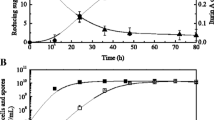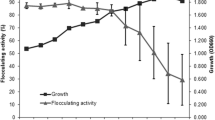Abstract
The co-culture of Bacillus subtilis IFO 3335 with Rhizopus peka P8 or Rhizopus oligosporus P12 in liquid medium was found to increase production of antibiotic activity and to alter the spectrum of activity relative to the pure cultures. However, a mixed culture of Rhizopus arrhizus P7 and Rhizopus oryzae P17 did not produce antibiotic activity. The concentration, ratio, and time of addition of B. subtilis to the R. peka culture was found to influence antibiotic yields. Solid-state fermentations using mixed cultures of R. peka and B. subtilis were investigated. The growth of Escherichia coli IFO 3792 as a target bacterium was inhibited by the mixed culture. These results suggest the possibility of biopreservation of fermented foods by novel co-culture systems.





Similar content being viewed by others
References
Banerjee BA, Bose KS (1964) Biosynthesis of mycobacillin, a new antifungal peptide role of nucleic acid. J Bacteriol 87:1397–1406
Benech RO, Kheadr EE, Lacroix C et al (2002) Antibacterial activities of nisin Z encapsulated in liposomes or produced in situ by mixed culture during cheddar cheese ripening. Appl Environ Microbiol 68:5607–5619
Domon HM, Mathieu GL, Repentigny DJ (1981) Changes in the activity of antifungals in mixed cultures of bacteria and yeast. Can J Microbiol 27:843–846
Du XL, Jia JS, Lu PF (2003) Morphological changes of Rhizopus chinesis 12 in submerged culture and its relationship with antibiotic production. Process Biochem 38:1643–1646
Harwood CR (1992) Bacillus subtilis and its relative: molecular biological and industrial workhorses. Trends Biotechnol 10:247–256
Hesseltine CW (1965) A millennium of fungi, food, and fermentation. Mycologia 57:149–197
Hoyt RP, Sizemore KR (1982) Competitive dominance by a bacteriocin-producing Vibrio harveyi strain. Appl Environ Microbiol 44:653–658
Jurus AM, Sundberg JW (1976) Penetration of Rhizopus oligosporus into soybean in tempe. Appl Environ Microbiol 32:284–287
Katz E, Demain LA (1977) The peptide antibiotics of Bacillus: chemistry, biogenesis, and possible functions. Bacteriol Rev 41:449–474
Kobayashi S, Okazaki N, Koseki T (1992) Purification and characterization of an antibiotic subdtance produced from Rhizopus oligosporus IFO 8631. Biosci Biotech Biochem 56:94–98
Leifert H, Chidburee S, Hsmpson S et al (1995) Antibiotic production and biocontrol activity by Bacillus subtilis CL27 and Bacillus pumilus CL45. J Appl Bacteriol 78:97–108
Lemos LM, Dopazo PC, Toranzo EA et al (1991) Competitive dominance of antibiotic-producing marine bacteria in mixed cultures. J Appl Bacteriol 71:228–232
Mitsue T, Tachibana K, Fujio Y (1999) Efficient kefiran production by a mixed culture of Lactobacillus kefiranofaciens KF-75 and yeast strains. Seibutsu-kogaku 77:99–103
Morita H, Fukuda T, Kawakita H (2004) Effects of some metal ions on the production of an antibacterial substance by Rhizopus sp. MKU 24. Biocontrol Sci 9:111–115
Mulyowidarso KR, Flete HG, Buckle AK (1989) The microbial ecology of soybean soaking for tempe production. Int J Food Microbiol 8:35–46
Mulyowidarso KR, Fleet HG, Buckle AK (1990) Association of bacteria with the fungal fermentation of soybean tempe. J Appl Bacteriol 68:43–47
Nout JM, Rombouts MF (1990) Recent developments in tempe research. J Appl Bacteriol 69:609–633
Patel SP, Huang S, Fisher S et al (1995) Bacillaene, a novel inhibitor of procaryotic protein synthesis produced by Bacillus subtilis: production, taxonomy, isolation, physico-chemical characterization and biological activity. J Antibiot 48:997–1003
Pinchuk VI, Bressollier P, SoroKulova BI et al (2002) Amicoumacin antibiotic production and genetic diversity of Bacillus subtilis strains isolated from different habitats. Res Microbiol 153:269–276
Samson AR, Van Kooij JA, De Boer E (1987) Microbiological quality of commercial tempeh in the Netherlands. J Food Prot 50:92–94
Sasaki Y, Takao S, Hotta K (1970) Conversion of fumaric fermentation to succinic acids fermentation by the association of Rhizopus and Bacteria. J Ferment Technol 48:776–781
Shimizu H, Mizuguchi T, Tanaka E et al (1999) Nisin production by a mixed-culture system consisting of Lactococus lactis and Kluyveromyces marxianus. Appl Environ Microbiol 65:3134–3141
Sumi H (1997) Antibacterial activity of Bacillus natto—growth inhibition against Eschricchia coli O-157. Bioscience 14:47–50
Taniguchi T, Nakazawa H, Takeda O et al (1998) Production of a mixture of antimicrobial organic acids from lactose by co-culture of Bifidobacterium longum and Propionibacterium freudenreichii. Biosci Biotechnol Biochem 62:1522–1527
Tuncle MG, Nout RJ, Rombouts MF (1989) Effect of acidification on the microbiological composition and performance of tempe starter. Food Microbiol 6:37–43
Wang LH, Ellis JJ, Hesseltine WC (1972) Antibacterial activity produced by molds commonly used in oriental food fermentations. Mycologia 64:218–221
Yamada Y, Ohtani Y, Mitsui Y et al (2001) Production of menaguinone (vitamine K2)-7 by Bacillus subtilis. J Biosci Bioeng 91:16–20
Acknowledgments
The authors thank Kaori Morita, Kazuhiro Noguche, Ying Wang, and Kana Morita for technical assistance.
Author information
Authors and Affiliations
Corresponding author
Rights and permissions
About this article
Cite this article
Fukuda, T., Yamamoto, S. & Morita, H. Changes in the antibiotic production by co-culture of Rhizopus peka P8 and Bacillus subtilis IFO3335. World J Microbiol Biotechnol 24, 1893–1899 (2008). https://doi.org/10.1007/s11274-008-9690-x
Received:
Accepted:
Published:
Issue Date:
DOI: https://doi.org/10.1007/s11274-008-9690-x




